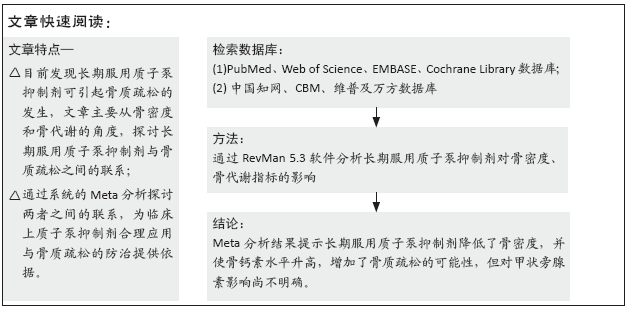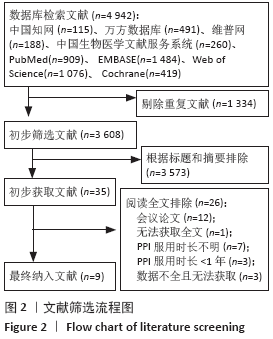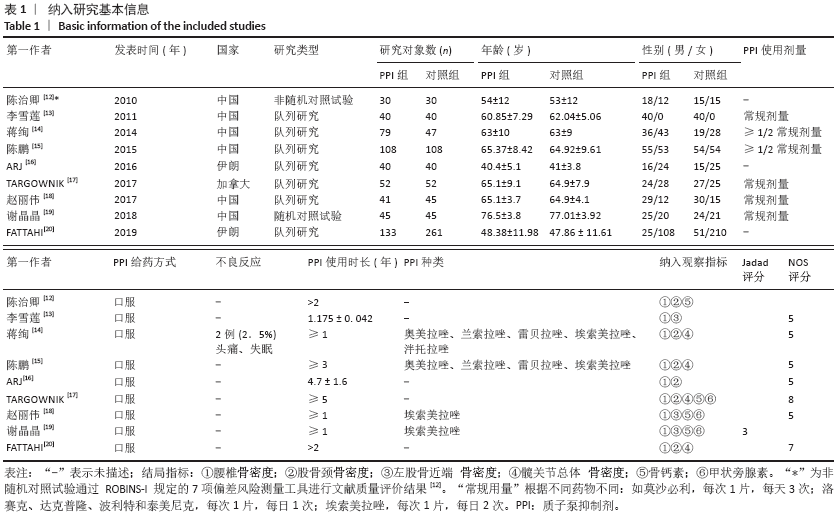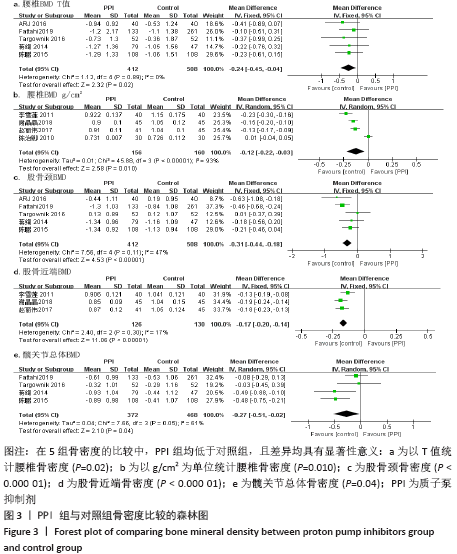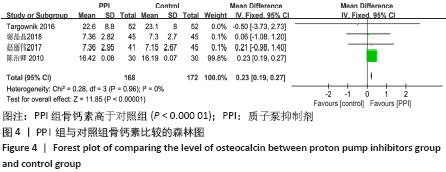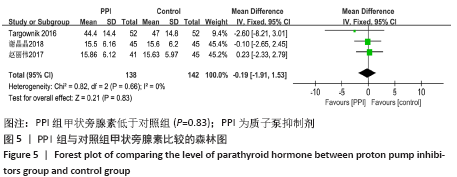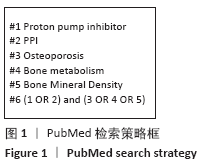[1] SHIN, YH, GONG HS, BAEK GH. Lower Trabecular Bone Score is Associated With the Use of Proton Pump Inhibitors. J Clin Densitom. 2019;22(2):236-242.
[2] ITO T, JENSEN RT. Association of long-term proton pump inhibitor therapy with bone fractures and effects on absorption of calcium, vitamin B12, iron, and magnesium. Curr Gastroenterol Rep. 2010;12(6):448-457.
[3] THOMSON ABR, SAUVE MD, KASSAM N, et al. Safety of the long-term use of proton pump inhibitors. World J Gastroenterol. 2010;16(19):2323-2330.
[4] UMAR S, RANA A, KAPETANOS A. Long-term proton pump inhibitor use in primary care internal medicine resident clinic. Am J Gastroenterol. 2017;112:S597.
[5] UEBERSCHAER H, ALLESCHER HD.. Proton pump inhibitor-side effects and complications of long-term proton pump inhibitor administration. Zeitschrift Fur Gastroenterologie. 2017;55(1): 63-74.
[6] NASSAR Y, RICHTERS. Proton-pump inhibitor use and fracture risk: an updated systematic review and meta-analysis. J Bone Metabolism. 2018;25(3):141-151.
[7] van der Hoorn MMC, Tett SE, de Vries OJ, et al. The effect of dose and type of proton pump inhibitor use on risk of fractures and osteoporosis treatment in older Australian women: a prospective cohort study. Bone. 2015;81:675-682.
[8] 张萌萌,张秀珍,邓伟民,等.骨代谢生化指标临床应用专家共识(2020)[J].中国骨质疏松杂志,2020,26(6):1-31.
[9] JADAD AR, MOORE RA, CARROLL D, et al. Assessing the quality of reports of randomized clinical trials: is blinding necessary? Control Clin Trials. 1996;17(1):1-12.
[10] STERNE JA, HERNáN MA, REEVES BC, et al. ROBINS-I: a tool for assessing risk of bias in non-randomised studies of interventions. BMJ. 2016;355:i4919.
[11] STANG, A. Critical evaluation of the Newcastle-Ottawa scale for the assessment of the quality of nonrandomized studies in meta-analyses. Eur J Epidemiol. 2010L25(9):603-605.
[12] 陈治卿.骨质疏松与质子泵抑制剂相关性探讨[J].中国骨质疏松杂志,2010,16(7): 504-505, 514.
[13] 李雪莲,周力.长期应用质子泵抑制剂对老年男性消化性溃疡患者骨密度的影响[J].贵阳医学院学报, 2011,36(5):528-529.
[14] 蒋绚,张庆文,张振宇,等.长期应用质子泵抑制剂的风险观察[J].中华医学杂志, 2014,94(4):284-288.
[15] 陈鹏,唐进先,吴冬寒.胃溃疡患者应用质子泵抑制剂的远期风险研究[J].中国中西医结合消化杂志,2015,23(9):615-617, 621.
[16] ARJ A, RAZAVI ZADE M, YAVARI M, et al. Proton pump inhibitors use and change in bone mineral density. Int J Rheum Dis. 2016;19(9): 864-868.
[17] TARGOWNIK LE, GOERTZEN AL, LUO Y, et al. Long-term proton pump inhibitor use is not associated with changes in bone strength and structure. Am J Gastroenterol. 2017;112(1):95-101.
[18] 赵丽伟,刘改芳,吴婧,等.长期服用质子泵抑制剂对老年胃食管反流患者骨密度、骨代谢指标及胃泌素水平的影响[J].中国老年学杂志,2017,37(14):3525-3526.
[19] 谢晶晶,方莉莉,陈吓妹.长期服用质子泵抑制剂对老年胃食管反流患者骨度、骨代谢指标及胃泌素水平的影响[J].临床合理用药杂志,2018,11(32):44-45.
[20] FATTAHI MR, NIKNAM R, SHAMS M, et al. The Association Between Prolonged Proton Pump Inhibitors Use and Bone Mineral Density. Risk Man Health Policy. 2019;12: 349-355.
[21] 毛旭峰,杨樟卫.质子泵抑制剂临床超适应证使用的医疗大数据分析[J].药学实践杂志, 2020,38(2):184-188.
[22] FOODD, ADMINISTRATION. FDA Drug Safety Communication: possible increased risk of fractures of the hip, wrist, and spine with the use of proton pump inhibitors. Accessed May. 2010.
[23] YANG SD, CHEN Q, WEI HK, et al. Bone fracture and the interaction between bisphosphonates and proton pump inhibitors: a meta-analysis. Int J Clin Exp Med. 2015;8(4):4899-4910.
[24] 于丽媛,龚晓健,王永庆.长期使用质子泵抑制剂致骨质疏松的研究进展[J].药学与临床研究,2017,25(3):237-242.
[25] HYUN JJ, CHUN HJ, KEUM B, et al. Effect of omeprazole on the expression of transcription factors in osteoclasts and osteoblasts. Int J Mol Med. 2010;26(6):877-883.
[26] KARSDAL MA, HENRIKSEN K., SøRENSEN MG, et al. Acidification of the Osteoclastic Resorption Compartment Provides Insight into the Coupling of Bone Formation to Bone Resorption. Am J Pathol. 2005;166(2):467-476.
[27] GOLTZMAN D, MANNSTADT M, MARCOCCI C. Physiology of the Calcium-Parathyroid Hormone-Vitamin D Axis. Front Horm Res. 2018;50:1-13.
[28] CASTIGLIONI S, CAZZANIGA A, ALBISETTI W, et al. Magnesium and osteoporosis: current state of knowledge and future research directions. Nutrients. 2013;5(8):3022-3033.
[29] 商晓盼,李涛,陆雨桐,等.镁离子在骨代谢中的分子机制研究与进展[J].中国组织工程研究,2016,20(48):7280-7287.
[30] HARTMAN B, DONNELLY-VANDERLOO M, WATSON T, et al. Proton-pump inhibitor therapy and vitamin B12 status in an inpatient hospital setting. Appl Physiol Nutr Metab. 2016;41(10):1071-1076.
[31] HERRMANN M, PETER SCHMIDT J, UMANSKAYA N, et al. The role of hyperhomocysteinemia as well as folate, vitamin B(6) and B(12) deficiencies in osteoporosis: a systematic review. Clin Chem Lab Med. 2007;45(12): 1621-1632.
[32] LAPUMNUAYPOL K, THONGPRAYOON C, WIJARNPREECHA K, et al. Risk of fall in patients taking proton pump inhibitors: a meta-analysis. QJM. 2019;112(2):115-121.
[33] WALSH JH, RICHARDSON CT, FORDTRAN JS. pH dependence of acid secretion and gastrin release in normal and ulcer subjects. J Clin Invest. 1975;55(3):462-468.
[34] BEKTAŞ M, SARAç N, CETINKAYA H, et al. Effects of Helicobacter pylori infection and long-term proton pump inhibitor use on enterochromaffin-like cells. Ann Gastroenterol. 2012;25(2):123-127.
[35] BIOSSE-DUPLAN, M. BAROUKH B, DY M, et al. Histamine promotes osteoclastogenesis through the differential expression of histamine receptors on osteoclasts and osteoblasts. Am J Pathol. 2009;174(4):1426-1434.
[36] SAHARA T, ITOH K, DEBARI K, et al. Specific biological functions of vacuolar-type H(+)-ATPase and lysosomal cysteine proteinase, cathepsin K, in osteoclasts. Anat Rec A Discov Mol Cell Evol Biol. 2003;270(2):152-161.
[37] 王敏娇,司家文,沈国芳.促进骨形成的甲状旁腺激素:作用及机制[j].中国组织工程研究,2015,19(15):2405-2409.
|
